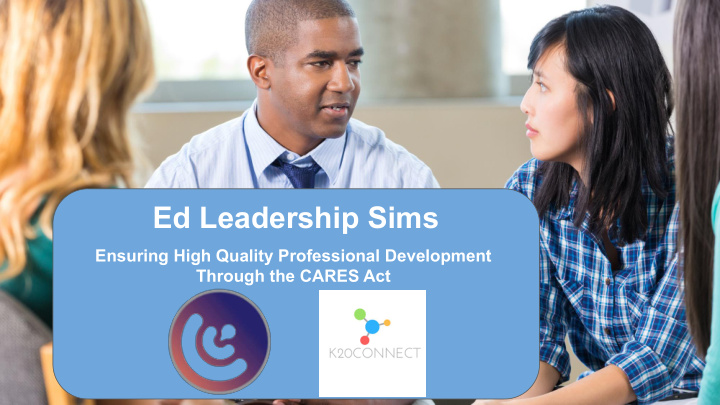



Ed Leadership Sims Ensuring High Quality Professional Development Through the CARES Act
Meet the Presenters Susan Gentz Dr. Kecia Ray susan@k20connect.net Keciaray@k20connect.net ● Principal and owner of K20Connect ● Partner K20Connect ● Instructor at John Hopkins University ● Chairman of the board at IEP Equity ● Former executive director at the ● Deputy Executive Director at the Center for Digital Education Center for Digital Education ● Board member at Learning Bird ● Former policy manager at the international association for K-12 online learning
The CARES Act Funding ● What does the CARES Act do? ● $13.5B for K-12 Education ● $3B for Governor’s Emergency Education Relief Fund (GEER Fund) ● $180M for the Rethink K-12 School Models & Continue to Learn Microgrants ● Student-Centered Funding Pilot ● Private schools are eligible for the K-12 parts of the program and the governors fund if the public-school district receives a grant ● Keeping American Workers Employed and Paid Small Business Loans: $350 billion
Applying for CARES Act Funding ● Simple and streamlined ● ESSER application ○ A completed cover sheet that includes the signature of the Chief State School Officer or authorized representative. (Part A of the Certification and Agreement) ○ Programmatic, fiscal, and reporting assurances. (Part B of the Certification and Agreement) ○ Information on the uses of ESSER funds. (Part C of the Certification and Agreement) ○ Other assurances and certifications. (Part D of the Certification and Agreement)
Waivers from the Department of Education ● Section 1127(b) of Title I, Part A of the ESEA to waive the 15% carryover limitation for Title I, Part A funds; ● Section 421(b) of the General Education Provisions Act (GEPA) to extend the period of availability of prior fiscal year funds, for Title I, Parts A-D, Title II, Title III, Part A, Title IV, Parts A-B, and Title V, Part B programs, and the McKinney-Vento Homeless Children and Youth program;
Waivers Continued ● Section 4106(d) of Title IV, Part A of the ESEA to waive a needs assessment to justify the use of funds; ● Section 4106(e)(2)(C), (D), and (E) of Title IV, Part A of the ESEA to waive content-specific spending requirements; ● Section 4109(b) of Title IV, Part A of the ESEA to waive spending restrictions on technology infrastructure; and ● Section 8101(42) of the ESEA to waive the definition of "professional development," which might otherwise limit the ability to quickly train school leaders and teachers on topics like effective distance learning techniques.
Strategically using your Carryover ● Allow districts to carry over as much Title I money as they want from this academic year to the next one -- Normally states are only allowed to carryover 15%. ● Look at strategies to bundle carryover funds with new stimulus funds.
Holistic Planning to Stimulus Dollars for Professional Development ● This is a critical time for educators to learn ● Create a professional learning environment that simulates blended learning ● Virtual, engaging options are available ● Telemed support through medicare/medicaid ● Build your pipeline of innovative leaders
Free, Online PD Opportunity June 11th 2pm EST EdLeadershipSims.com
Recommend
More recommend